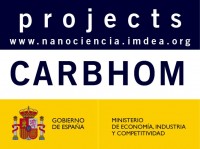CARBHOM Homogeneous Linewidth Spectroscopy of Carbon Quantum Dots
Prof. Reinhold Wannemacher
-
Funding :
MINECO MAT2015-71879-P
-
Duration: 2016 - 2018
-
36 months
Carbon Dots (CD) are an emerging class of carbon materials with unique properties, such as high fluorescence quantum yield, high photo-stability, wavelength tunability, stability in aqueous suspensions, non-toxicity, and bio-compatibility. They have promis ing applications in the fields of bio-imaging and bio-sensing, potentially replacing toxic semiconductor nanoparticles or dyes. In addition, they can be mass-produced, at low cost, from readily available and cheap biomaterials, including bio-waste. As CD are excellent donors, as well as acceptors, they are currently intensely investigated also for applications in solar energy conversion, and photo-catalysis. Moreover, CD have very recently been incorporated into processable polymers, including polymer sheets and electro-spun fibers, which further increases the palette of possible applications.
However, to fully utilize the potential of CD, it is necessary to have an in-depth understanding of their optical properties and optical interactions within the QD and with the environment, including photo-induced charge transfer. The present proposal aims at a detailed investigation of these properties using advanced homogeneous line width spectroscopic techniques, such as Fluorescence Line Narrowing (FLN), Spectral Hole-Burning (SHB), Optically Detected Magnetic Resonance (ODMR) using SHB, and Single Molecule Spectroscopy (SMS), as well as Surface-enhanced Raman spectroscopy (SERS). The proposed experiments are expected to yield detailed information on the photophysics of CD.
http://nanociencia.imdea.org/images/nanociencia/scientific_reports/Scientific-Report-2016.pdf#page=158




